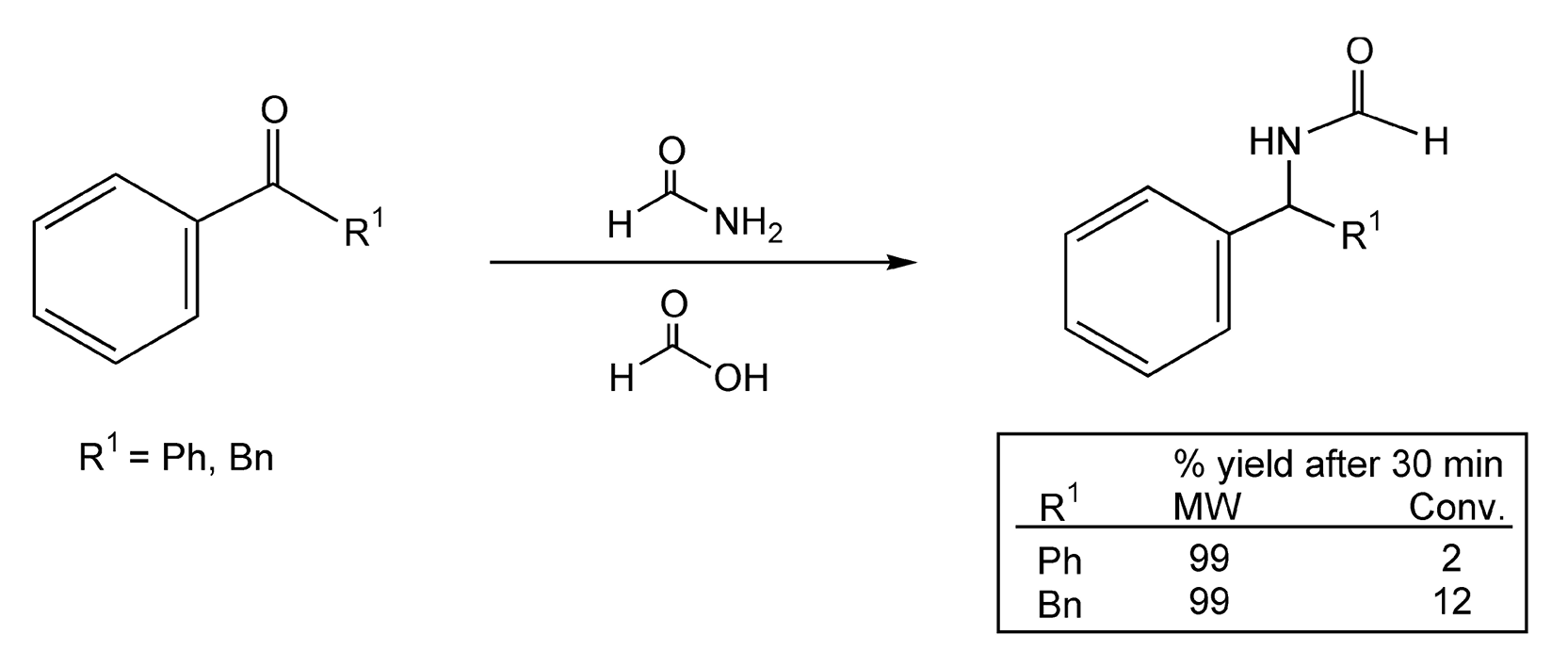Reductions
Reductions are very useful synthetic transformations and encompass a wide variety of applications. Microwave irradiation has been used to enhance yields and reaction rates of carbonyl to alcohol reductions573-579, reductive amination of carbonyl compounds580-582, aromatic nitro group reduction to amines583, carbon–carbon double bond hydrogenations584-587, and hydrogenolysis of functional groups11,587-589.
Many versatile reagents can reduce ketones to secondary alcohols and aldehydes to primary alcohols. Sodium borohydride is widely used, as it is inexpensive, compatible with solvents, and safer to use than other reducing agents. Its major drawback is that solvents reduce its reaction rate and a large excess of the reagent is needed to successfully reduce any compound. Varma and co-workers have impregnated alumina with NaBH4 and have reduced ketones and aldehydes with microwaves in a solvent-free environment (Scheme 102).576 These reactions only required 1-5 equivalents of reducing agent and gave 80-93% product yields.

Scheme 102
Reductive amination of carbonyl compounds is one of the most useful methods for synthesizing amines and their derivatives. The Borch reduction utilizes sodium borohydride derivatives for direct reduction to amines, while the Leuckart reaction produces N-formyl derivatives by using formamides. These reductions are plagued by high temperatures and long reaction times. Varma et al. used his NaBH4 impregnated on support method, this time with clay, to effect reductive aminations on carbonyl compounds in five minutes or less.582 Schiff bases (imines), generated in situ with microwaves on clay, followed by NaBH4-clay addition, produce secondary amines in high yields (Scheme 103). Loupy and co-workers have synthesized N-formyl derivatives with microwave-enhanced Leuckart reactions in 30 minutes (Scheme 104).581

Scheme 103

Scheme 104
Aromatic nitro groups can be reduced to amines by numerous methods in the solution phase. Conventional reaction conditions usually consist of the nitro compound, hydrazine hydrate, and a metal catalyst in refluxing ethanol or dioxane. Long reflux periods are required for successful reduction. As a solution, microwave-induced reduction with alumina-supported hydrazine and iron(III) chloride provided 100% conversion to aromatic amines (Scheme 105).583

Scheme 105
In order to continue their research in microwave enhanced β-lactam synthesis, Bose and co-workers have developed hydrogenation and hydrogenolysis methods that utilize ammonium formate and either a Raney nickel or Pd/C catalyst (catalytic transfer hydrogenation).587 As seen in Scheme 106, Raney nickel will only hydrogenate the carbon–carbon double bond, while use of a Pd/C catalyst will both hydrogenate and cleave the carbon–nitrogen bond (Scheme 107).

Scheme 106

Scheme 107
Complete reduction of a carbonyl group can be accomplished by the Wolff-Kishner reaction. Traditionally, these reactions require high temperatures and long reaction times. With microwave irradiation, reduction is completed in minutes with near quantitative product yields (Scheme 108).588,589

Scheme 108
Instruments
11. Bose, A.K.; Manhas, M.S.; Ghosh, M.; Shah, M.; Raju, V.S.; Bari, S.S.; Newaz, S.N.; Banik, B.K.; Chaudhary, A.G.; Barakat, K.J. “Microwave-induced organic reaction enhancement chemistry. 2. Simplified techniques.” J. Org. Chem. 1991, 56, pp. 6968-70.
573. Feng, J.C.; Liu, B.; Dai, L.; Yang, X.L.; Tu, S.J. “Microwave assisted solid reaction: reduction of esters to alcohols by potassium borohydride-lithium chloride.” Synth. Commun. 2001, 31, pp. 1875-77.
574. Hajipour, A.R.; Mallakpour, S.E. “Butyltriphenyl-phosphonium tetrahydroborate (BTPPTB) as a selective reducing agent for reduction of organic compounds.” Synth. Commun. 2001, 31, pp. 1177-85.
575. Barbry, D.; Torchy, S. “Accelerated reduction of carbonyl compounds under microwave irradiation.” Tetrahedron Lett. 1997, 38, pp. 2959-60.
576. Varma, R.S.; Saini, R.K. “Microwave-assisted reduction of carbonyl compounds in solid state using sodium borohydride supported on alumina.” Tetrahedron Lett. 1997, 38, pp. 4337-38.
577. Bagnell, L.; Strauss, C.R. “Uncatalyzed hydrogen-transfer reductions of aldehydes and ketones.” J. Chem. Soc., Chem. Commun. 1999, pp. 287-88.
578. Erb, W.T.; Jones, J.R.; Lu, S.Y. “Microwave enhanced deuteriations in the solid state using alumina doped sodium borodeuteride.” J. Chem. Res. (S) 1999, pp. 728-29.
579. Chen, S.T.; Yu, H.M.; Chen, S.T.; Wang, K.T. “Microwave assisted solid reaction: reduction of ketones using sodium borohydride.” J. Chin. Chem. Soc. 1999, 46, pp. 509-11.
580. Loupy, A.; Monteux, D.; Petit, A.; Merienne, C.; Aizpurua, J.M.; Palomo, C. “Leuckart reductive amination of a 4-acetylazetidinone using microwave technology.” J. Chem. Res. (S) 1998, pp. 187, 915-21.
581. Loupy, A.; Monteux, D.; Petit, A.; Aizpurua, J.M.; Dominguez, E.; Palomo, C. “Towards the rehabilitation of the Leuckart reductive amination reaction using microwave technology.” Tetrahedron Lett. 1996, 37, pp. 8177-80.
582. Varma, R.S.; Dahiya, R. “Sodium borohydride on wet clay: solvent-free reductive amination of carbonyl compounds using microwaves.” Tetrahedron 1998, 54, pp. 6293-98.
583. Vass, A.; Dudas, J.; Toth, J.; Varma, R.S. “Solvent-free reduction of aromatic nitro compounds with alumina-supported hydrazine under microwave irradiation.” Tetrahedron Lett. 2001, 42, pp. 5347-49.
584. Bose, A.K.; Manhas, M.S.; Banik, B.K.; Robb, E.W. “Microwave-induced Organic Reaction Enhancement (MORE) chemistry: techniques for rapid, safe, and inexpensive synthesis.” Res. Chem. Intermed. 1994, 20, pp. 1-11.
585. Al-Qahtani, M.H.; Cleator, N.; Danks, T.N.; Garman, R.N.; Jones, J.R.; Stefaniak, S.; Morgan, A.D.; Simmonds, A.J. “Microwave enhanced hydrogenation reactions using solid hydrogen, deuterium, and tritium donors.” J. Chem. Res. (S) 1998, pp. 400-01.
586. Dayal, B.; Ertel, N.H.; Rapole, K.R.; Askaongar, A.; Salen, G. “Rapid hydrogenation of unsaturated sterols and bile alcohols using microwaves.” Steroids 1997, 62, pp. 451-54.
587. Banik, B.K.; Barakat, K.J.; Wagle, D.R.; Manhas, M.S.; Bose, A.K. “Microwave-assisted rapid and simplified hydrogenation.” J. Org. Chem. 1999, 64, pp. 5746-53.
588. Gadhwal, S.; Baruah, M.; Sandhu, J.S. “Microwave induced synthesis of hydrazones and Wolff-Kishner reduction of carbonyl compounds.” Synlett. 1999, 10, pp. 1573-74.
589. Parquet, E.; Lin, Q. “Microwave-assisted Wolff-Kishner reduction reaction.” J. Chem. Educ. 1997, 74, p. 1225.

